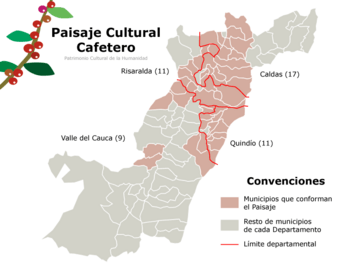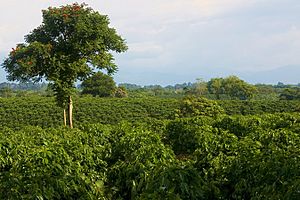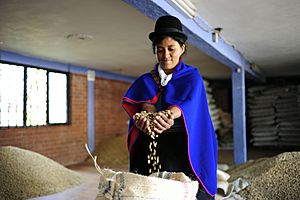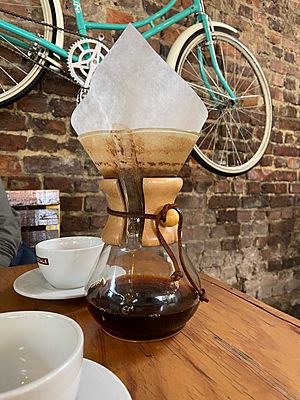Coffee production in Colombia facts for kids
| UNESCO World Heritage Site | |
|---|---|

Colombia's coffee growing axis is a World Heritage Site
|
|
| Location | Colombia |
| Criteria | Cultural: (v), (vi) |
| Inscription | 2011 (35th Session) |
| Area | 141,120 ha (348,700 acres) |
| Buffer zone | 207,000 ha (510,000 acres) |
Colombia is famous for its mild and well-balanced coffee beans. It's one of the top three coffee producers in the world, after Brazil and Vietnam. However, Colombia grows the most arabica coffee beans, which are known for their great taste. Colombian coffee is sent all over the world, especially to countries like the United States, Germany, France, Japan, and Italy.
Most of this coffee comes from a special area called the Colombian coffee growing axis. Other places, like Sierra Nevada de Santa Marta, focus on making really high-quality coffee. In 2007, the European Union recognized Colombian coffee with a special status, meaning it's protected and known for its origin. Then, in 2011, UNESCO declared Colombia's "Coffee Cultural Landscape" a World Heritage Site. This means it's a very important place culturally and historically.
Coffee plants first arrived in Colombia around 1790. A Jesuit priest named José Gumilla wrote about seeing coffee plants in 1730. Another report from 1787 also mentioned coffee growing in the northeast parts of the country.
Contents
How Coffee Started in Colombia
The first coffee farms were in the eastern part of Colombia. In 1808, the first coffee was sold and shipped out. About 100 bags of green coffee were sent from the port of Cucuta. A priest named Francisco Romero helped spread coffee farming in the northeast. He even asked people to plant coffee as a way to make up for their sins!
Coffee farming then grew in different areas like Santander, North Santander, Cundinamarca, Antioquia, and the historic region of Caldas.
Coffee Becomes a Big Export
Even though coffee started early, it didn't become a huge export for Colombia until the second half of the 1800s. The world economy was growing a lot then. This gave Colombian landowners a great chance to sell their coffee to other countries. The United States became the biggest buyer of coffee, and Germany and France were important markets in Europe.
Challenges for Coffee Farmers
At first, big landowners in Colombia tried to export other things like tobacco and quinine. But these didn't last. When the prices for these products fell, the farms struggled. They weren't building a strong, lasting export business.
Then, at the end of the 1800s and early 1900s, coffee prices dropped. On top of that, a war called the Thousand Days War made things even harder. Big coffee farms couldn't keep their plantations in good shape. Many of them had borrowed a lot of money, and they ended up losing everything. Coffee farms in Santander and North Santander faced big problems, and those in Cundinamarca and Antioquia stopped growing.
A New Way to Grow Coffee

This crisis changed the Colombian coffee industry a lot. Starting around 1875, more and more small coffee farms began to appear. This happened in Santander, parts of Antioquia, and the Old Caldas region.
By the early 1900s, a new way of growing coffee had become popular. It was based on small, family-owned farms. People moved to new areas in the center and west of Colombia, like Antioquia, Caldas, Valle, and northern Tolima. This shift meant that the western parts of Colombia became leaders in the coffee industry.
Growing coffee was a great choice for these small farmers. It allowed them to use their land intensely and permanently. Unlike older farming methods that left land unused for long times, coffee let them grow crops all the time. It didn't need a lot of special tools, and farmers could still grow food for themselves. This helped a new coffee culture grow, led by many small farms.
The National Federation of Coffee Growers

Even with many small farmers, Colombia's coffee industry wasn't very strong in the global market at first. But between 1905 and 1935, things changed. The industry grew a lot thanks to the creation of the National Federation of Coffee Growers of Colombia (FNC) in 1927.
This Federation brought together local farmers and small producers. Together, they could solve problems with shipping and selling coffee that they couldn't fix alone. The Federation also started a research center called Cenicafé in 1938. This center helped farmers learn better ways to grow coffee and improve its quality.
Today, coffee is grown all over the mountains and hilly regions of Colombia. It provides income for over 500,000 families who farm coffee.
Climate Change and Coffee
Climate change can affect how much coffee Colombia produces. Between 2006 and 2010, some reports said that coffee production went down. This was because average temperatures rose and rainfall increased, which isn't ideal for the Coffea arabica bean. However, from 2011 to 2018, Colombia's coffee production actually increased significantly, reaching 14.2 million bags. This shows that farmers are adapting to changing conditions.
The Coffee Growing Axis
The coffee growing axis, also known as the coffee triangle, is a special part of Colombia. It includes three departments: Caldas, Quindío, and Risaralda. These are some of the smallest departments in Colombia, but they are very important for coffee. In 2011, UNESCO made this region a World Heritage Site.
Marketing Colombian Coffee
National Federation of Coffee Growers of Colombia
The National Federation of Coffee Growers of Colombia (FNC) is a non-profit group. It's famous for its "Juan Valdez" marketing campaign. The Federation started in 1927 to help produce and export Colombian coffee. It represents more than 500,000 coffee farmers, most of whom own small family farms.
The FNC helps with research to improve coffee growing. It also makes sure that Colombian coffee meets high quality standards for export. The Federation had three main goals when it started: to protect the coffee industry, to study its problems, and to help it grow. The "Juan Valdez" idea began in 1981. Its goal was to show that Colombian coffee is 100% pure. Juan Valdez, a farmer with his mule, first appeared on TV in 1983.
Juan Valdez
Juan Valdez is a fictional character who represents Colombian coffee farmers. He is a symbol of the hard work and dedication that goes into growing high-quality Colombian coffee.
National Coffee Park
The National Coffee Park is a theme park in Colombia dedicated to coffee. It's a fun place where visitors can learn about the history and culture of coffee in Colombia, and enjoy rides and attractions.
See also
 In Spanish: Café de Colombia para niños
In Spanish: Café de Colombia para niños


